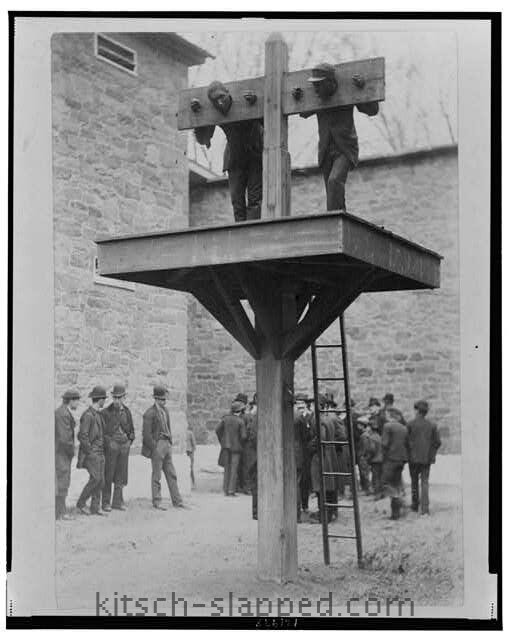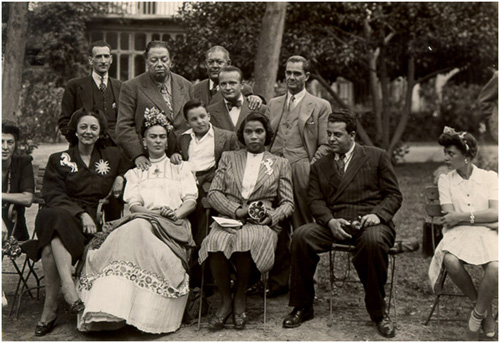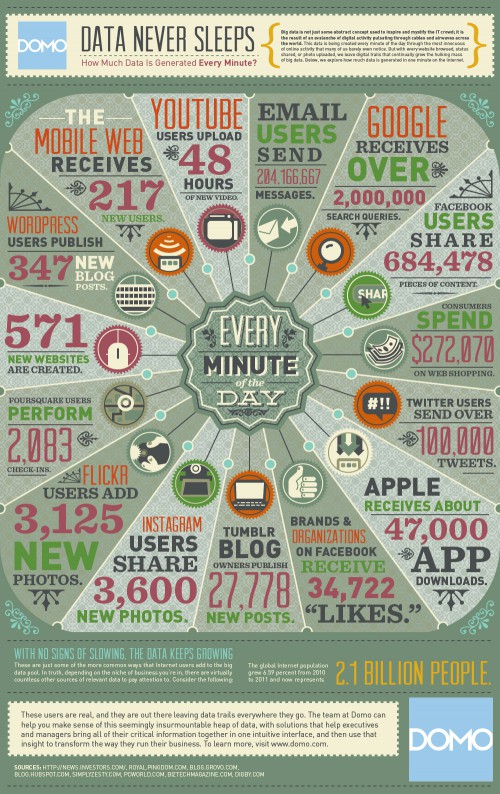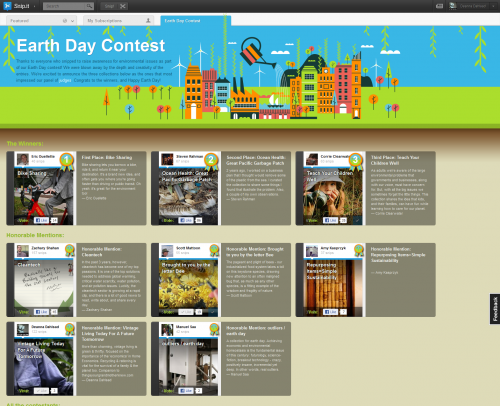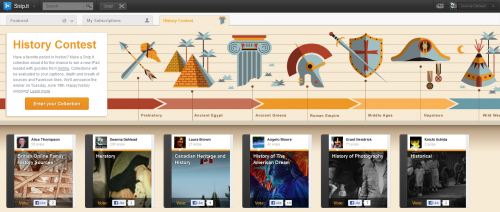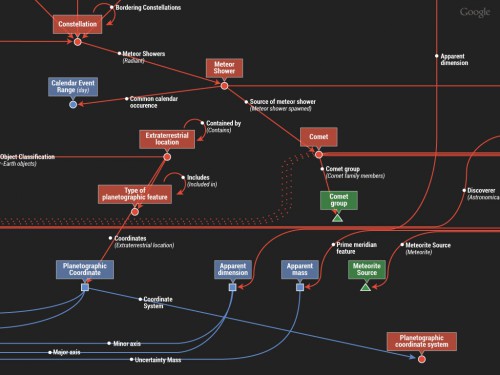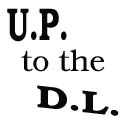Holy crap! Yesterday, I published an article about journalist Edward R. Murrow; and just now I published one about fashion designer Sophie Gimbel. In looking for images for that last article, I found this: a photo of Edward R. Murrow with Sophie Gimbel! I love, love, love this sort of circular serendipity of context! (That’s Sophie’s husband, Adam Gimbel, on the stairs; photo circa 1955.)
Tag: blogging
Context Is Credibility
I’ve written before about the importance of context; and ranted too about “stolen” images used, uncredited etc., at Tumblr and other sites. I’ve tweeted and posted at Facebook about my hatred of such things. Others have taken a far more direct and pointed-tongued approach (NWS) regarding the issue. But Sarah Werner‘s It’s History, Not A Viral Feed is the most direct and well-articulated article — complete with excellent resources.
Men being punished for "Posting Pictures Without Proper Attribution," date and source unknown. pic.twitter.com/A2vOILcvFL
— A. History (@AhistoricalPics) January 24, 2014
— A. History (@AhistoricalPics) January 24, 2014
Blogging Death Knells Are Premature & Passe
This sort of “blogging is dead, especially for business” thinking as shared in Beyond Blogging: 13 Content Marketing Opportunities for Ecommerce by Linda Bustos drives me nuts:
Remember when business blogging was really big? You know, 2007-ish, before Twitter, Facebook, Pinterest and Instagram came and stole all that consumer attention span.
The death of Google Reader may just be one more signal that blogging is passe, at least as a marketing tool for commercial products.
Only 25% of the 85 retail blogs we tracked in 2007 are still actively updated today. That’s a 75% abandonment rate.
So if blogging’s dead, what content marketing opportunities remain for ecommerce?
First of all, the majority of the sites listed rely on content produced elsewhere to fill them — not only curation sites, like Pinterest & Scoop.It, but social media sites, like Facebook & Twitter (which are also blogging or micro-blogging), as well. Without blogs and websites creating content, what is there to curate or share? And, in fact, at least half of the 13 “opportunities” Bustos lists are actions (content, curation) performed at blogs; many are actually dependent upon blogs specifically for content, and at least three of them (Infographics, Newsletter/email, QRated content) require blogs or websites to make them work.
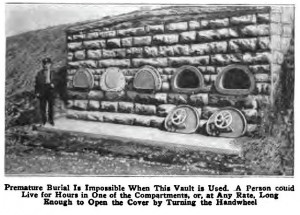 If The Future is based on blogging, how can it be dead?
If The Future is based on blogging, how can it be dead?
Secondly, there are major issues with the subject of blog abandonment rate claims. Blogs, like the static sites before them, have always had high abandonment rates. Since 2004, Technorati’s State of the Blogosphere has been examining such things as the supposed “death” of blogs — and the more the death rumor waves rolled in, they rolled back out again as more data put the rumors out to sea. Sure, blogs are abandoned. Blogging has made it super easy for the code-ignorant to self-publish — come on in, the water’s fine! And, like so many self-directed activities, such ease has allowed them to self-perish just as easily. Any one of those reasons can just as easily be applied to curating or “Facebooking”. (But, by the way, did you do any digging to see why that 75% of retail blogs were abandoned? Are the companies still around? Have multiple blogs been combined? Have blogs been rolled into retail sites? Have they simply been “guest blogging” at other sites, or using Facebook Pages?)
Beneath all of this, however, is the fundamental issue of what blogging is.
I’ve long contended that blogging is a method of publishing; it’s the software, the mechanism, the platform. In that case, Facebook, Twitter, etc. are platforms for blogging. Platforms which are far more controlled by others than the single stand-alone sites which Bustos & others call blogs and are trying to declare dead. But to say “blogging is dead” is a more than premature; it’s just plain not true.
You can split-hairs over what blogging is or isn’t, which platforms, software, distribution methods etc. are trending now and where it might go tomorrow, but whatever you call it, people will be creating and many of them will opt to control their creations as well. (…Well, many of us will do our best to try to control as best we can in this Digital Wild West. And for many of us, that means our own sites and even our own servers. Because as we are learning more every day, sites and platforms come & go every single day. And censorship is a threat. Wise folks who value their creations know that using another party’s service/site/platform has plenty of risks.)
Whether the blogging/self-publishing mechanism changes is not really an issue, for as technology advances it certainly will change. But the creation of content itself will remain. And (hopefully!) we will always have individuals involved who will opt to retain their roles of both creator and publisher, i.e. their own blogs and sites (whatever they’ll be called), for which the curators, sharers, etc. should be most thankful.
Image Credits: Wikipedia
I’m Betting You Need To Do This
 I’ve just finished a round of website reviews, and I’m here to tell anyone listening (which includes contacting a slew of former clients with whom I remain in close contact) that you need to implement or update your About and/or FAQ pages.
I’ve just finished a round of website reviews, and I’m here to tell anyone listening (which includes contacting a slew of former clients with whom I remain in close contact) that you need to implement or update your About and/or FAQ pages.
I know a number of bloggers using Blogger (Blogspot blogs) either avoided creating such pages or simply made posts they linked to and have passed out of mind as they have passed from sight. But now that Blogger offers “pages,” you’re out of excuses.
I know a number of people who said their site was so new no questions had been asked, let alone any questions frequently asked, so they put it off for another day… Those days have rolled into how many seasons or even years now? *wink*
Even those of you who took great efforts to create such information pages should really take another look at them…
The truth is About pages and FAQs are quite popular and important pages. They are where people look to make contact with you, where they look for more information to evaluate if and how to do business with you. That business may be buying ad space, arranging a link swap, or finding additional information needed in order to commit to buying your widget. In any case, every time that page isn’t found, you’ve likely lost that sale.
After the round of such poor and just plain missing pages, I’m almost certain your site’s About and FAQ pages would benefit from a critical update. I’d bet my reputation on it.
Would you bet your reputation on them? Because you are, you know.
If you aren’t sure that your primary information pages are up to snuff, get them (and the rest of your site) evaluated by with a website review.
If you’re not sure just what information is necessary, which questions and answers should be on your FAQ, contact us about a consultation. We can assist you with a simple list of what you need, write it for you — even code it for you, if necessary. Contact me with your needs and budget.
Borders Bleed & Blow My Mind (Thoughts On Context)
Sometimes history is thought of as it is taught: In separate chunks. But history passes, weaves, and certainly is attached and connected to time — the time behind it, the time before it, and simultaneously to persons and events which, even in attempts to understand and reclaim, we have neatly severed into subjects and categories.
History and culture isn’t simply a matter of dates or compartmentalized periods. The subject of context isn’t merely one for writers, bloggers or content curationists, i.e. photo or image with research or text story, properly credited, for real readers. Context is even more than the object, person, or event in cultural context of what came before it, what came after it. Context must include what and who are contemporaries.
For example, do you think of opera legend Marian Anderson and artist Frida Kahlo as contemporaries? As friends even? Most probably do not.
[About the image: Marian Anderson and Frida Kahlo with Diego Rivera, Miguel Covarrubias, Rosa Covarrubias, Ernesto de Quesada and others in Mexico, 1943.
More astonishing than this photo which went wild on Tumblr is the video.
The video is silent home film footage of that same trip, from the Penn Libraries Marian Anderson collection, A Life In Song, use of and upload to YouTube approved by Nancy M. Shawcross, Curator of Manuscripts, Rare Book & Manuscript Library, University of Pennsylvania on June 19, 2012.]
For in our (admirable) attempts to reclaim lost stories of Black Women and Hispanic Women (groups who have felt marginalized from Feminism and Women’s Studies), separate stories emerge. Separate stories may narrow focus, provide an ease for our brains (which many falsely claim are over-stimulated and bombarded with information; information overload is a myth) tasked with absorbing information, but so many separate stories not only lead to false notions of separate lives issues (which fosters a sense of competition, risks alienation, and further divides what is Us), but removes the full complex beauty of cultural context.
Oxford University historian Dr. Cliff Davies, in his discussion of the myth of the Tudor era, describes this compartmentalization of history as “seductive” and helping “to create the idea of a separate historical period, different from what came before and after.” I say this seduction also includes the temptation to remove the context of contemporaries. And that it ought to be avoided. Even in an age of working to create filtered focus.
Even when you have multiple blogs, collections, and curated topics — each with its own focus, there is likely to be some overlap between them. If you are aware of and include context with your collections, there will be, ought to be, some repeated content and objects across collections. Even those with the most dedicated focus.
I consider this to be not redundant overlap but more connections, yet another layer to your stories. Practically speaking from a marketing approach, it is another way to find more readers too.
And another way to blow their minds.
Facts & Questions on Blogging, Curating & Collecting
I’ve been getting a lot of “What the heck is curating?” questions, largely in response to my request for votes (“Likes”) on a topic I’m curating at Snip.It, but also because, despite what Forbes has to say about it going mainstream, content curation is a rather “new” thing. I had thought I’d done a rather good job of defining content curation here, but either I haven’t or people haven’t read that post. But that’s OK too, because it gives me a chance to go into a bit more detail.
Content curation is to magazine and newspaper publication what blogging has been to writing or journalism: A digital-age means of self-publishing which is primarily based on platforms (software or code) available to anyone with access to the Internet.
The big names in blogging platforms or publishing software are WordPress, Blogger, Typepad, etc. In content curation, you have Pinterest, Scoop.It, and, my favorite, Snip.It (RIP). These content curation platforms are not the first; but like Facebook, which improved (and capitalized) upon the early social networking sites which came before it, these three curation sites are emerging as the top dogs. (Also like Facebook, these content curation sites have social networking aspects — and they do connect to social media, including Facebook at Twitter.) And it’s merely a matter of time before you somehow become involved with content curation sites; be it by curating, subscribing/reading, or, as some forecast, using curated content topics as your search engine.
But what does that mean? How is that really different from blogging? And why on earth would we need another means of adding to information overload?
Firstly, information overload is a myth. Humans have always had far more information and media available then it can devour. (So as not to get too far astray, I’ll send you here for more details on that.) Even if the push of media makes it seem worse, such technological shifts in our relationships to information are, as James Gleick, author of The Information: A History, A Theory, A Flood, “part of the evolution of the species.” The true problem is, or remains, that of how an individual human can find what he wants or separate the good from the bad, i.e. a filter.
And that’s where content curation comes in.
Content curation is the process of sorting, arranging, and publishing information that already exists. Like any collector or museum curator, content curators identify and define their topics, select which items to include (and often how they are displayed), while providing the context, annotations, and proper credits which not only assist their readers but identify themselves as more than interested but invested; a leader or an authority.
Content curators are being dubbed “superheroes” (by Steve Rosenbaum, author of Curation Nation: How to Win in a World Where Consumers are Creators, and others) because content curators are saving humans everywhere from the skill and drudgery of finding and filtering themselves. Rosenbaum even says that people will pay “for clarity, authority, context, and speed” of finely calibrated filters.
If this all sounds a lot like what you (or others) do as a blogger, it just may be. Many bloggers spend their time selecting what they consider the best of what other people have created on the web and post it at their own sites, just like a magazine or newspaper. Or they provide a mix of this along with writing or otherwise creating their own content. Not to split hairs, but curation involves less creation and more searching and sifting; curation’s more a matter of focused filtering than it is writing.
Because content curation is expected to be based on such focused filtering, it begins far more based on topic selection. This is much different from blogging, where bloggers are often advised to “just begin” and let their voice and interests accumulate over time to eventually reveal a primary theme. Perhaps the best way to ascertain the difference is to consider this in terms of collecting styles.
Some collectors just collect what they like as they stumble into it. In fact, many collectors, including myself, began this way; letting their collections evolve until a definition or purpose seems to reveal itself. …Sometimes, collectors just keep piling up stuff, no matter what it is. Even if this isn’t hoarding, it’s not-so-much of a purposeful pursuit. But professional curators, those who manage collections for museums or other organizations, and serious collectors, they maintain a specific focus. And rather than stumbling into items, they continually seek for specific items. The definition dictates the curation — and everything from funding to their continued employment is based on how well their collection meets the collection’s definition.
While blogging success may be thought of in many different ways, the success of content curation lies in how well you define, search/research, and stick to your subject.
Image Credits: Data Never Sleeps infographic via Domo
Curating For You; Vote For Me
[This post has been sitting in “draft” format for so long, I’m actually embarrassed! Perhaps it sat so long because I’m too embarrassed to toot my own horn?]
If you follow some of my other blogs, you know that I’ve added “content curation” or online collecting to my blogging activities. My favorite site to do this is Snip.It — and not just because I earned an Honorable Mention for my Vintage Living Today For A Future Tormorrow collection in their Earth Day contest. *wink*
Now Snip.It has a History Contest:
Make a Snip.it collection all about your favorite period in history (anything from The Enlightenment to Pre-colonial America to Gen X) for the chance to win a new iPad loaded with goodies from Inkling. We’ll evaluate the collections based on depth and range of sources (dig deep!), your captions, and Facebook likes.
You can enter a collection and snip into it anytime between now and when we choose a winner on Tuesday, June 19th.
More details here.
Whether you enter or not, please visit my Herstory collection — and if you like it, please hit the Facebook “Like” button and even subscribe. Thanks!
Working The Knowledge Graph
As I’ve said before, “Search engines are based on programs or algorithms which do their best to interpret what a searcher wants and, attempting to replicate human understanding, gives it to them based on the text or written content it can find.”
So Google’s announcement of, Google’s Knowledge Graph, a major shift in the way it looks at searches, focusing on trying to “think” even more like a human, i.e. less in keywords and phrases.
The Knowledge Graph enables you to search for things, people or places that Google knows about—landmarks, celebrities, cities, sports teams, buildings, geographical features, movies, celestial objects, works of art and more—and instantly get information that’s relevant to your query. This is a critical first step towards building the next generation of search, which taps into the collective intelligence of the web and understands the world a bit more like people do.
More at Mashable, where the funky infographic came from.
Things I Learned At and About Tumblr

These are some of the things I learned about the site.
Tumblr is far more social network or community oriented than a standard “blog”; or maybe it’s more accurate to say that Tumblr is more of an intense microcosm of blogging. The posts are shorter, more rapid, more plentiful — mainly because nothing is actually created there. Instead it’s based on reposting what others have created around the Internet, and then reposted and reposted over at Tumblr, in and out of the interconnected social circles of followers.
Tumblr is so based on the notion of regurgitating the posts and reposts of others, that the only real way to keep up is to stay logged in to Tumblr and sit at your dashboard, where you can see all the reposts of those you follow go by. For this reason, it has an addicting quality. But the price of such a glut of rehashed stuff is the need for more speed — people clicking repost as fast as they can, more stuff flying at you.
That can be a time waster, but let’s look at the more important things in terms of promoting your business, your site, your writing.
Tumblr is incredibly image oriented. Text posts and links are virtually ignored. Even when the photo you post has text or a link, these are seldom what makes a post popular i.e. reposted. In fact, your text and link have at least a 60% chance of being removed by the person reposting it. And link click-through rates, even when the link is the image credit (i.e. clicking the photo to get a larger version), are much lower than at regular blogs and websites — including in the adult area.
That is the number on reason why using Tumblr to market your site or business is ineffective.
The popularity of a post is reposting. “Likes” do very little for you (since they are a one-click thing not requiring them to leave the dashboard, they are just a way for a user to more quickly add their “note” to a post).
Readers, followers, etc. are numbers that don’t matter as much as the long string of “notes” (the list of people who reposted and liked the post). This is obviously increased by the number of people following you; but as long as your post is reposted by someone and reaches another circle of users, your post will go on and on, showing up on your dashboard over and over again. But, if no one is clicking the links, visiting your store etc., then so what?
Tumblr is also not the best way to have conversations with your customers or your target market either.
Comments are not actually built into the system (though you can add DISQUS) and conversations are discouraged in general. You can send a message via the “ask me” feature, but if you answer it, it’s published at your Tumblr — and the one who asked or commented does not get a notice of it. So unless they are logged in, are following you, and see it on their dashboard, how will they know you replied? And in order to continue the conversation, one of you will have to go back to the “ask” and start again. It’s incredibly awkward.
Tumblr is also a rather closed community in the sense that anonymous (non-Tumblr users) are clearly second class citizens. In your Tumblr settings, you can allow or disallow anonymous to “ask” questions, but unless they say, “Hi, it’s Susan,” or otherwise identify themselves, you won’t know who it is because Tumblr either recognizes a logged in user or labels them anonymous.
While the rest of the Internet is trying to engage readers across platforms, regardless of whether or not they are an official user/subscriber, Tumblr and, more importantly, Tumblr users deride and mock the “anons.”
That’s a closed community.
And now we get to the issue of what most irks people about Tumblr…
Contrary to what most of us were taught, having something unique to say or offer is not important at Tumblr. In fact, unless you are a big wig at Tumblr, your original content is likely to go completely unappreciated. People prefer to repost what the cool kids repost rather than be the person who finds unique or new things. These are the majority of the users at Tumblr.
The other group of users is a smaller group, but they are far too often those with larger followings. These are the folks who like to pose as the news makers, the creators, taking credit for what they found with the omission of where they found it, who owns it, etc. — and they are to blame for Tumblr’s poor reputation, even if the majority users are guilty of perpetuating it with all the reposts.
Some blame the ease of Tumblr’s reposting and sharing widget are to blame for this, but if people were truly lazy and using Tumblr as it is, nearly every image raped from a site would have a link crediting where it was found (and, one hopes, more information on original source, etc.). But these people take great efforts to right-click-save an image, then upload it to Tumblr — never crediting the photographer, scanner, or image owner.
This is a malicious act. It’s done on purpose. It requires more effort than the one or two click of the Tumblr Bookmarklet sharing widget — and it’s done so they can act as if they put the time in on something they didn’t. Often times, once they’ve saved the image on their computer, they’ll even go so far as to remove copyright and URL information before uploading and posting to Tumblr.
The number of people who post that they’re “going home to scan more photos of X” — and then perform image searches for such photos and scans are astonishing. Those of us who spend the time scanning know what our scans look like — where there’s a wrinkle on the page, tanning, if we included text or not, etc.
All of this would be the silly poser stuff of teenagers — if it weren’t so infuriating. Because the bottom line is, there are many big bloggers out there who are so popular because they find and credit the cool stuff; they are like antique dealers who are adored by collectors with less time.
As if this weren’t bad enough, many Tumblr users take great pride in expressing their indifference and defiance regarding copyright and intellectual property. Sidebars and profiles are filled with “I find stuff lots of places and if you’re one of the credit nazis, don’t follow me” and similar statements that I gather are supposed to appear as cool non-conformist, punk-rebellious, barbs at The Man. Unfortunately, the Internet is not The Man; so the ones they hurt are the ones who create the content — artists, photographers, dedicated folks who scan antique and vintage works, etc.
No, Tumblr is not a good way to market your product, your website, etc.
Yeah, this post is so not going to make me popular at Tumblr. But what am I going to miss? Even more of my content going out and about uncredited?
I have since deleted my old test accounts at Tumblr. But I do retain a personal account there for two reasons:
One, a few ethical people I met there only post at Tumblr and so I can keep up with them
Two, sometimes logging in and scrolling the Tumblr dashboard provides some good leads on cool stuff. Such a stream of photos can provide a quick way to see things — but it’s deceptive in the sense that once I spy something cool, I’ll have to put a lot of work in to searching for the images. (For that I use TinEye; a detailed account of how and why to use it is here — the site is NWS.)
And when I do use it, it can be a tremendously frustrating time suck because so much uncredited stuff is coming at you so fast.
So overall, I do not recommend Tumblr as an effective way to market yourself or your blog; but it has its entertainment value and can be useful if you don’t invest too much time in it.
UP to the DL: Blog Tours & Marketing Services
ABOUT:
U.P. to the D.L. is the dynamic duo of Deanna Dahlsad & Laura Brown, two wordy grrls who met 10 years ago as columnists at (the now defunct) Backwash.com.
Of course, both had been writing and promoting online (and off) long before that time, so the slow demise of one site didn’t keep them from continuing to do what they do — or being friends. *wink*
Our latest joint projects are Inherited Values and Ululating Undulating Ungulate. (If you visit the sites and are interested in joining us there, please check out the “about” pages!)
Because of our years of experience in the Internet trenches, we’ve long been individually helping other writers, bloggers, artists, sellers, and entrepreneurs start-up or increase their online presence; now we’ve joined forces, offering you our firsthand knowledge and experience.
We offer specialized services, such as:
Bloggers, you have brands too, so any of these services can be tailored to suit you!
You can keep up with U.P. to the D.L. by following us at Twitter and you may contact us at Deanna.Pop.Tart@gmail.com.
A detailed FAQ of services can be found here.
The most familiar sort of Blog Tour is the Book Blog Tour, which is the virtual version of yesteryear’s book tour. At UP to the DL, we don’t limit the idea to only books — you can use blog tours to promote anything, any product or service, including, simply, yourself.
This virtual version of a promotional tour isn’t so bad; it’s cheaper, less frustrating than traveling, and, as Arielle Ford (former book publicist, literary agent and the author of seven books) says at The Huffington Post, you “essentially spend the day in your bathrobe while interacting with your readers and fans and selling books.”
However, if you aren’t familiar with all the details involved, virtual tours can become real nightmares!
Organizing a Blog Promotional Tour involves:
- Identifying potential hosts — that will reach your target audience
- Contacting potential hosts
- Making the pitch, helping sort through the options with hosts
- Scheduling the tour and individual host actions
- Answering technical questions and concerns of hosts
- Performing the check-ups and follow-ups necessary to ensure a good tour
- Proper timing of it all!
And, if you are an organized person with enough time to do all of this, do you know what things are most vital to a successful tour?
- Do you really know how to identify your target market and evaluate which of the millions of blogs, podcasts, zines, newsletters, etc. are honestly able to reach them?
- Do you know how to anticipate, avoid and over-come host/blogger concerns?
- If you have a limited number of products (or none at all) to give-away for reviews and contests, do you know what other tour options you can offer — some of which are even more likely to garner the results you desire?
- Do you know what sort of tour events or activities will help you more increase cash flow, which are designed for long-term, how to maximize long tail results — and which ones you really need?
- Once you have secured hosts that will reach your target market, do you know how to best capture the attention of your potential readers or customers?
- Do you know what sorts of posts and tour activities will positively (or negatively) affect things such as PageRank (PR) and Search Engine Optimization (SEO)?
- Are you aware of and know how to address the legal and ethical issues in virtual tours?
- Do you know how to create promotional tours which will get bloggers excited to participate — and their readers converting to sales?
We do.
We’ve been writing, reading and buying online for over a decade. We know, as press, readers, and consumers what bores & what soars.
We know what pitches get, well, pitched via that delete button. We each have over a decade of networking with other bloggers, building relationships and contacts to ensure results.
We know what sorts of things discredit you, harm the reputation of you and your product or service. We will organize your online event so as to maximize your sales and your personal brand.
Hire U.P. to the D.L. as your blog tour coordinators and liaisons; we’ll maximize your presence and sales.
We know how to identify the online conversations and communities where your audience is congregating — and we know how to ethically participate in those relevant conversations so that you, your products, services, and brands are engaging with your customers and potential customers.
Blog Tour Package Rates:
(Details on what each blog tour includes are listed here; information on the process is also outlined here.)
One Week Basic Blog Tour: One week of blog tour events, including Tweets and other social networking site promotion for just $150.
Two Week Basic Blog Tour: Two weeks of blog tour events, including Tweets and other social networking site promotion for only $289.
Select & reserve your Basic Blog Tour package:
| Basic Blog Tour |
| Soft Blog Tour |
| Website Review |
Blog Tour Tips For Authors & Promoters
The success of your virtual promotional tour is dependent upon several factors which you influence:
- The number of books, products, gift certificates that you can provide for reviews, contests, etc.
- The amount of your participation in the events (interviews, offers, comments you post, Tweets you make, etc.), communication with U.P. to the D.L. and hosts, as requested.
- The strength and appeal of your book, product, service, brand, etc.
- The performance and appeal of your website, blog, etc.
- The number of response options you offer (newsletters to subscribe to, social sites you belong to for “following,” number and quality of sales outlets, etc.).
- Your efforts in promoting the tour, via your own site, BookTour.com, etc..
Authors who have traditional publishers (i.e. not self-published works) should check with the publisher, as they may pay for the Blog Tour fee, all or in part, &/or copies of the book out of the book’s promotional or PR budget.

At UP to the DL, we also provide tips for our clients on how to make the most of a tour once it has officially ended.
Ethics In Virtual Book Tours & Other Blog Tours

I personally don’t abide Paid Posts and proudly proclaim my No Payola status, but as those posts rather cover my sentiments, today I’ll focus on the ethics involved in Blog Tours — specifically in terms of the rules of UP to the DL Blog Tour Services.
These rules are based not only on the experiences we’ve had hosting blog tours, posting reviews, receiving pitches to promote this or that, but on fundamental ethics — good ol’ common sense. And these rules are designed to protect the integrity of bloggers, blog readers, consumers, and promoters alike.
Rule #1 It is not ethical to review something you’ve never used, read or otherwise employed; that’s fraud. Therefore, asking a person to commit a fraudulent act is unethical, at best.
Rule #2 It is unethical, to say the least, to insist a reviewer not publish or share a review that is not flattering. Such “reviews” are not reviews at all; reviews are to be thoughtful opinions, educated critiques, and, above all, honest. Individual hosts may, after reviewing the item and honestly disliking it, post their negative (but not hate-filled or personally attacking) review as they wish; or, they may wish to contact us for help regarding their conflicted responses and uncomfortable situations.
Rule #3 Follow-through on what you promise. Send your review copies, samples, contest prizes on time; publish your blog tour event as promised; get back to people as promised. In the rare cases where “life happens,” please contact U.P. to the D.L. as soon as possible to communicate and problem solve the situation.
Any and all persons who break these rules, are found to be guilty of such unethical behavior, will not be allowed to participate in any U.P. to the D.L. projects of any kind. Offenders may also find themselves the subject of unwanted press, with a public disclosure of their behavior.
I know these rules may sound more stern or even scary rather than inviting, but practicing these principles protects and respects the integrity of all involved! It is our expectation that everyone upholds these values and has a commitment to the rights of consumers and brands.
Have You Been Curated?
 Over at her blog, Laura’s posted about content curators. Unlike content creators, content curators filter and organize the content others have created — using their own passion and information to shape and give meaning to the resource (web directory, social media topic expert, “lens” editor, etc.) they are creating.
Over at her blog, Laura’s posted about content curators. Unlike content creators, content curators filter and organize the content others have created — using their own passion and information to shape and give meaning to the resource (web directory, social media topic expert, “lens” editor, etc.) they are creating.
As Laura notes, “A content curator can shape public opinion with the choices they make, the content they choose to include or pass by.” Placement in such curated resrouces affects not only individual readers, but systems such as search engines.
Have you identified which curated resources you, your blog, etc., must be in?
Have you contacted those curators which ought to know about you, your site, your business?
If there’s not really a great resource, why not start one?

